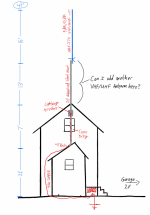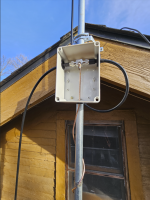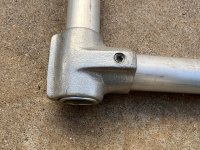arudlang
Member



Hello all!
Last fall I put up a used UHF/VHF ARX-270 that I got for free (used, broken). I repaired it as best I could and stuck it on a 20' piece of fence top post on my porch, attached with a decent foot mount on the porch roof and secured about 6-7' up on the peak of my house's roof. It's a little noodly in big winds but it stayed up there all winter.
Today we had our first little thunderstorm, didn't really worry about lightning over the winter here in Minnesota but I thought maybe some folks could weigh in on my efforts to lessen the risk and damage of a potential lightning strike re: having this antenna attached to my favorite wooden building here...
Partway down the mast I have a plastic box with a typical lightning arrestor. It is attached as best I could to a 4 gauge pure-copper solid ground wire I wrapped around the mast and then looped down and over to my service ground where the electric enters the house next to the porch. Not relying on the service ground, I did drive down my own 8' ground rod right next to the service ground and bonded my 4ga wire to both.
Other info, the coax (after the lightning arrestor in the box) goes into the upstairs window. I am putting together a large plastic cabinet inside the house to hold my gear (radios, duplexer, power supply, computer+SDRs, etc)
I have big ideas of DIY repeater stuff with the antenna. First up I plan to experiment with a DIY low power GMRS repeater. I have a lot of family within 6 miles and want to see what kind of family comms are possible. I also have a mini-PC and a couple of SDRs to play with, maybe implement some monitoring for local repeater activity. Also thinking of doing a part-time parrot repeater to aid in range tests. Won't go into deep details about that now, suffice to say I want to try all sorts of things with the ARX-270.
At the same time, there is one local ham repeater that is pretty active and I try to stay active on it myself. I have a "spare" radio with crossband repeat functionality and I've found it very useful to have that running, as I can take any cheap HT from my collection and wander around my property and even across town (if I'm using the ARX-270) and easily access this repeater which is ~30 miles away and not usually reachable from the HT on the ground.
The other day I was thinking "what if I put another VHF/UHF antenna somewhere on my property and just run the crossband repeater off of it while doing whatever other experiment with the ARX-270?
The thing is if I get a successful GMRS repeater going on the ARX-270 it might be used a fair amount as I have a lot of local interested family. I'm trying to gauge how I could potentially have both the GMRS repeater going and the crossband repeater to the local club tower without them causing each other too much interference.
Once up on my roof it doesn't take much to hit that club repeater. 5 watts is plenty. I wonder if I had a basic antenna, even an HT antenna, down towards the peak of my house on that same mast would the NULL of the two antennas and the 12(ish) feet of separation be enough to avoid them overloading each other if both were active? The GMRS repeater would have 10(ish) watts to the ARX-270 but with the high gain hopefully it throws so much of it to the horizon hardly anything would hit another VHF/UHF antenna below... Meanwhile a crappy HT dual band antenna below running 5 watts VHF/UHF crossbanding hopefully wouldn't dump an excessively harmful amount of RF into the ARX-270. Thoughts or opinions on that? I'm pretty sure it comes down to "I just gotta try it and see."
I'd kinda like to keep everything on that mast, as I already have the provisions for lightning mitigation and a short run to a nice equipment cabinet inside the window, with a big power supply to run everything I might want to run. I could consider putting the crossband repeater somewhere else nearby but I only have a half an acre to work with, nowhere on the property is very far from the ARX-270. I assume putting something on my garage roof 25 feet away would put them more at odds with each other than trying to stack them into each other's null zones(?)
But anyways, that's the latest around here. Sorry to cram two things into one thread. Still just looking for any glaring flaws in the lightning mitigation efforts, and then any thoughts about stacking two dual band antennas with active(ish) low power repeaters running on them like that.
Thanks in-advance for the thoughts and advice!




